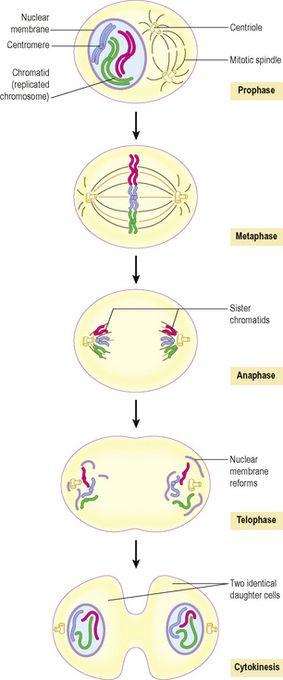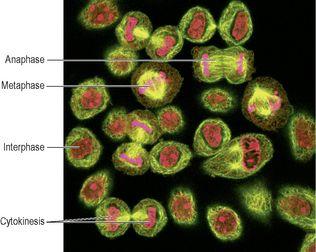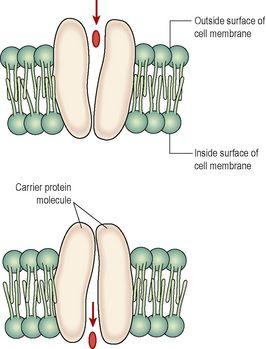Ross & Wilson Anatomy and Physiology in Health and Illness (18 page)
Read Ross & Wilson Anatomy and Physiology in Health and Illness Online
Authors: Anne Waugh,Allison Grant
Tags: #Medical, #Nursing, #General, #Anatomy

Figure 3.7
The cell cycle.
Interphase
This is the longer phase and three separate stages are recognised:
•
first gap phase (G
1
) – the cell grows in size and volume. This is usually the longest phase and most variable in length. Sometimes cells do not continue round the cell cycle but enter a resting phase instead (G
0
).
•
synthesis of DNA (S phase) – the chromosomes replicate forming two identical copies of DNA (see
p. 432
). Therefore, following the S phase, the cell now has 92 chromosomes, i.e. enough DNA for two cells and is nearly ready to divide by mitosis.
•
second gap phase – (G
2
) there is further growth and preparation for cell division.
This is a continuous process involving four distinct stages seen by light microscopy.
Figure 3.8
The stages of mitosis.
Figure 3.9
Mitosis.
Light micrograph showing cells at different stages of reproduction with chromatin/chromatids shown in pink.
Prophase
During this stage the replicated chromatin becomes tightly coiled and easier to see under the microscope. Each of the original 46 chromosomes (called a
chromatid
at this stage) is paired with its copy in a double chromosome unit. The two chromatids are joined to each other at the
centromere
(
Fig. 3.8
). The
mitotic apparatus
appears; this consists of two
centrioles
separated by the
mitotic spindle
, which is formed from microtubules. The centrioles migrate, one to each end of the cell, and the nuclear envelope disappears.
Metaphase
The chromatids align on the centre of the spindle, attached by their centromeres.
Anaphase
The centromeres separate, and one of each pair of sister chromatids (now called chromosomes again) migrates to each end of the spindle as the microtubules that form the mitotic spindle contract.
Telophase
The mitotic spindle disappears, the chromosomes uncoil and the nuclear envelope reforms.
Following telophase,
cytokinesis
occurs: the cytoplasm, intracellular organelles and plasma membrane split forming two identical daughter cells. The organelles of the daughter cells are incomplete at the end of cell division but they develop during interphase.
The frequency with which cell division occurs varies with different types of cell (
p. 40
).
Transport of substances across cell membranes
The structure of the plasma membrane provides it with the property of
selective permeability,
meaning that not all substances can cross it. Those that can, do so in different ways depending on their size and characteristics.
Passive transport
This occurs when substances can cross the semipermeable plasma and organelle membranes and move down the concentration gradient (downhill) without using energy.
Diffusion
This was described on
page 25
. Small molecules diffuse down the concentration gradient:
•
lipid-soluble materials, e.g. oxygen, carbon dioxide, fatty acids and steroids, cross the membrane by dissolving in the lipid part of the membrane
•
water-soluble materials, e.g. sodium, potassium and calcium, cross the membrane by passing through water-filled channels.
Facilitated diffusion
This passive process is used by some substances that are unable to diffuse through the semipermeable membrane unaided, e.g. glucose, amino acids. Specialised protein carrier molecules in the membrane have specific sites that attract and bind substances to be transferred, like a lock and key mechanism. The carrier then changes its shape and deposits the substance on the other side of the membrane (
Fig. 3.10
). The carrier sites are specific and can be used by only one substance. As there are a finite number of carriers, there is a limit to the amount of a substance which can be transported at any time. This is known as the
transport maximum
.
Figure 3.10
Specialised protein carrier molecules involved in facilitated diffusion and active transport.
Osmosis
Osmosis is passive movement of water down its concentration gradient towards equilibrium across a semipermeable membrane and is explained on
page 25
.
Active transport
This is the transport of substances up their concentration gradient (uphill), i.e. from a lower to a higher concentration. Chemical energy in the form of ATP (
p. 24
) drives specialised protein carrier molecules that transport substances across the membrane in either direction (see
Fig. 3.10
). The carrier sites are specific and can be used by only one substance; therefore the rate at which a substance is transferred depends on the number of sites available.
The sodium–potassium pump
This active transport mechanism maintains the unequal concentrations of sodium (Na
+
) and potassium (K
+
) ions on either side of the plasma membrane. It may use up to 30% of cellular ATP requirements.
Potassium levels are much higher inside the cell than outside – it is the principal intracellular cation. Sodium levels are much higher outside the cell than inside – it is the principal extracellular cation. These ions tend to diffuse down their concentration gradients, K
+
outwards and Na
+
into the cell. In order to maintain their concentration gradients, excess Na
+
is constantly pumped out across the cell membrane in exchange for K
+
.
Bulk transport (
Fig. 3.11
)
Transfer of particles too large to cross cell membranes occurs by
pinocytosis
or
phagocytosis
. These particles are engulfed by extensions of the cytoplasm (see
Fig. 15.1, p. 366
) which enclose them, forming a membrane-bound vacuole. When the vacuole is small, pinocytosis occurs. In phagocytosis larger particles (e.g. cell fragments, foreign materials, microbes) are taken into the cell. Lysosomes then adhere to the vacuole membrane, releasing enzymes which digest the contents.





